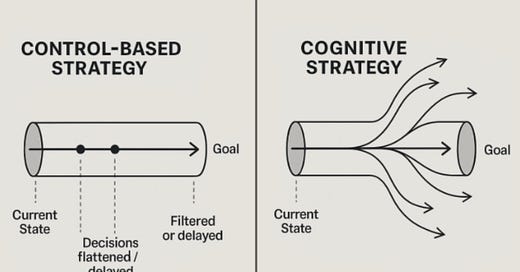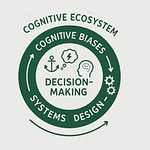The Old Way: Control-Based Strategy
So this is how I see the difference between old strategies—the control-based strategies that we still see in most organizations today—and cognitive strategies. These are strategies that adapt in real time because we're not trying to flatten the noise. We are trying to use all of the intelligence that's available to us.
In a control-based strategy—this is really traditional standard strategy, how we do anything, how we try and achieve any goal—we create a goal right at the end. And then we start at our current state. And as we move through this tunnel, with this sort of tunnel vision towards our goal, any new information that comes in, it's got no real way to join up with what we've already got. We're insulated there. We've put ourselves in a little tunnel and we're just moving towards our goal.
Now, what ends up happening is we might get these points where new information comes up, these dots that we can see in the control-based strategy. When that comes up—that's new signals, they're new information, they're new perspectives, they're new ideas—what happens in a control-based strategy is those things are flattened, right? Any decisions that need to be made outside of what we already have discussed, they get delayed.
So we keep moving down this tunnel in these control-based strategies where all of the new information, it gets filtered or it gets delayed because we're in pursuit of this one single goal.
Now, if we get every single thing right in that control-based strategy and we walk that pathway without moving off it even once, we will achieve our goal. We will get to the end and we will say, all right, we've done what we needed to do. We've moved from our old state and we've got to the goal.
That's a control-based strategy.
Set the goal.
Anything that comes in that is not fully aligned to the goal—flatten it.
Delay any decisions.
That's what happens in most organizations today. 99%.
The Alternative: Cognitive Strategies
The alternative are these cognitive strategies—these living strategies. And there, we don't get locked into this tunnel. We don't have this tunnel vision. Instead, we're accepting of all new types of intelligence. We're accepting of all new types of signals.
So we start with our current state. And as we move through our tunnel, we actually see our options start to widen. We know the direction that we need to head in. We know where our original goal is. But we also know that there's some possibilities around the side of that that actually aren't too bad, that actually would still mean winning. We just haven't considered all of them because we didn't have all of the information at the start.
So as we go through these cognitive strategies, we start to get new signals and we start to get new intelligence. And instead of flattening that information and instead of delaying those decisions, we follow them and we see where they go.
What that does is it doesn’t distract us from our original goal—it opens up more options for us to achieve and head towards our original goal.
And so all of these new arrows that we see coming off—these are people chasing down the goal in different ways. These are new possibilities that have been created because we've stopped to listen to what everybody had to put in, because we've used all of the intelligence in the room.
The Choice
And so you've got two options.
You can stay with the control-based strategy, which we know and it feels familiar and it works.
Or we can move towards a cognitive strategy, which allows people to give more of themselves and gives us a better chance of success.
Now, the option is totally up to you. But I know which option I choose every single time.
That's the cognitive strategy—just to be clear.
🔁 Enjoyed this model?
Join bold thinkers upgrading how we think each week — through science, sound, and smarter systems.
👉 Subscribe now to get the next upgrade loop.








Share this post